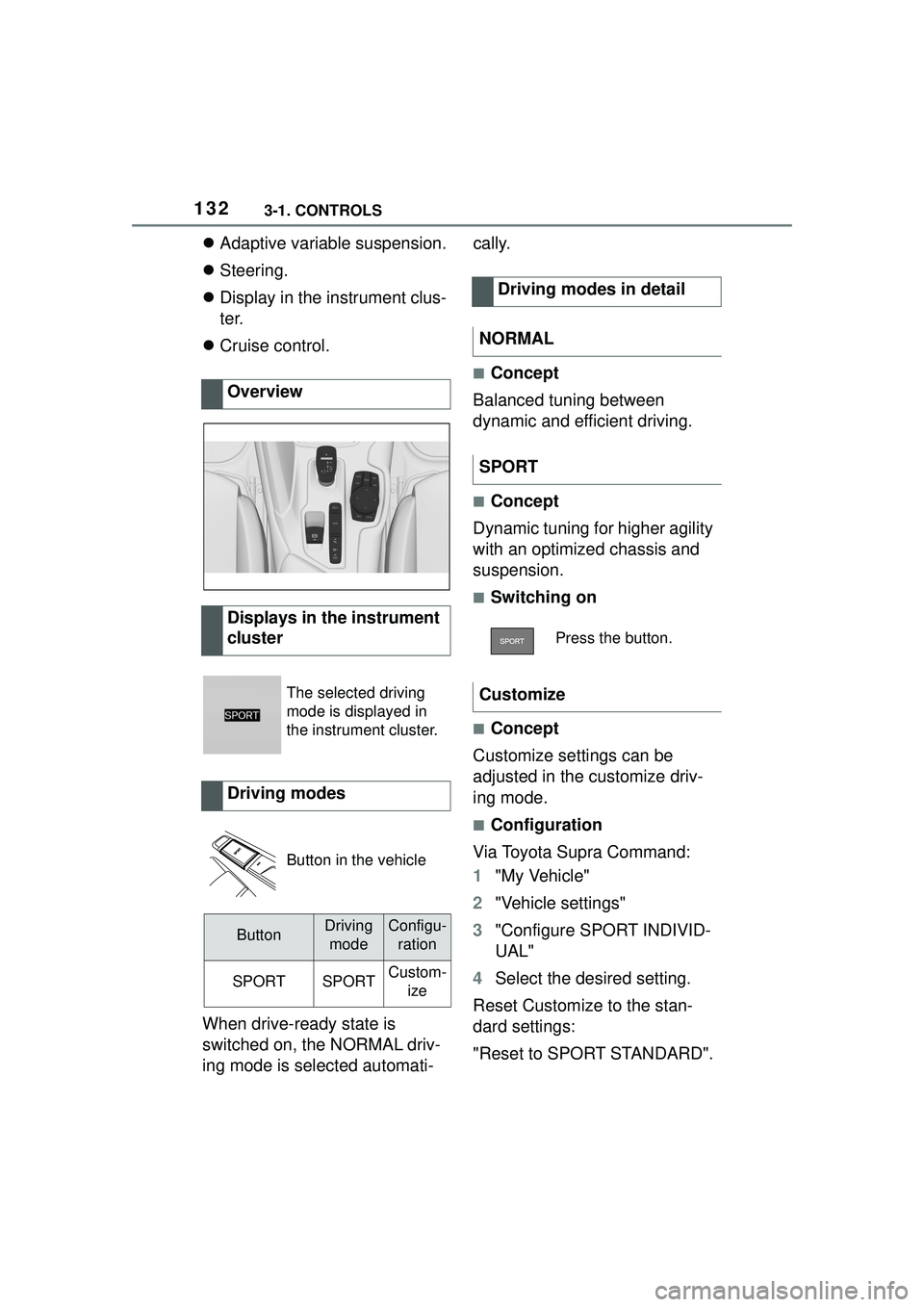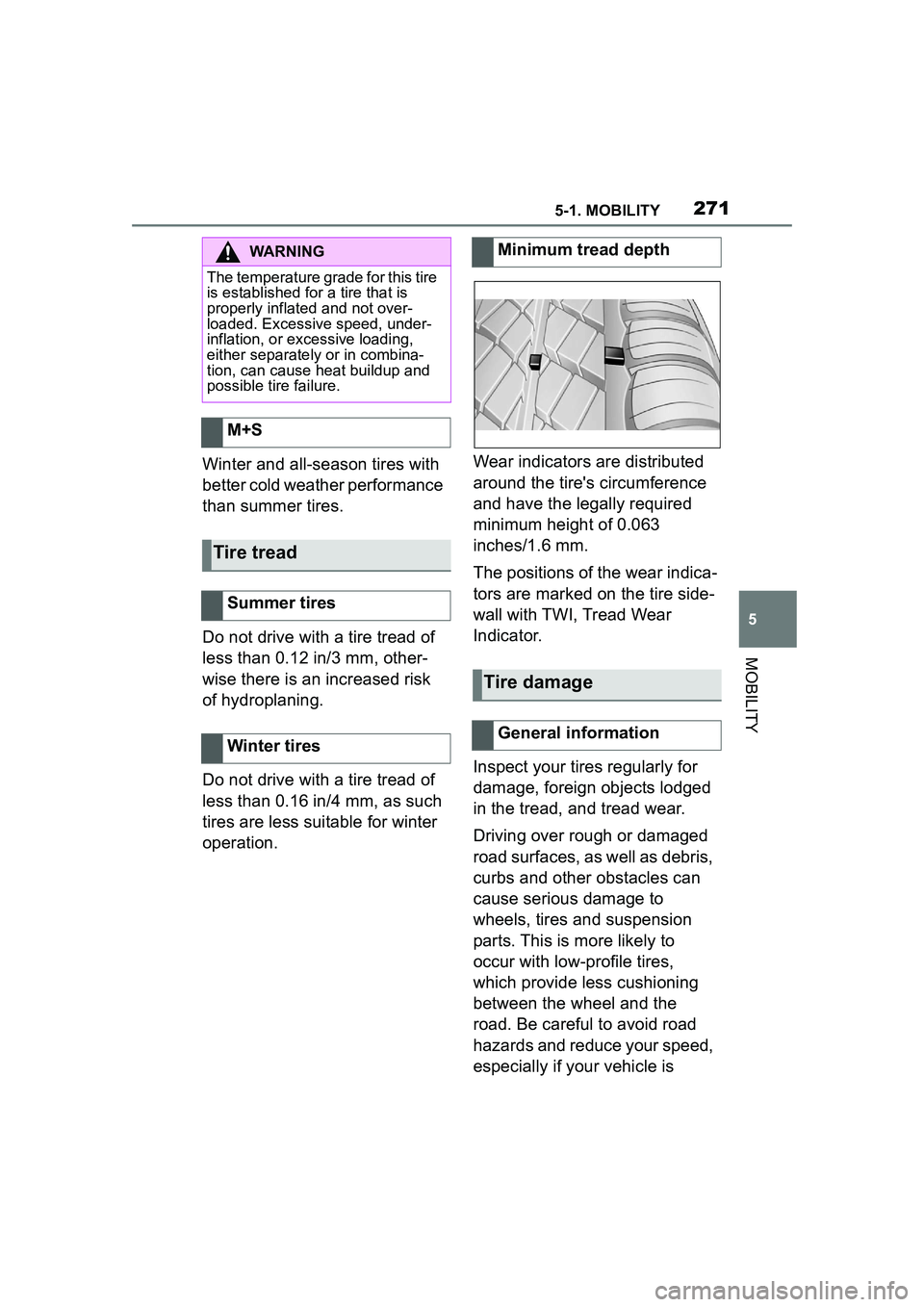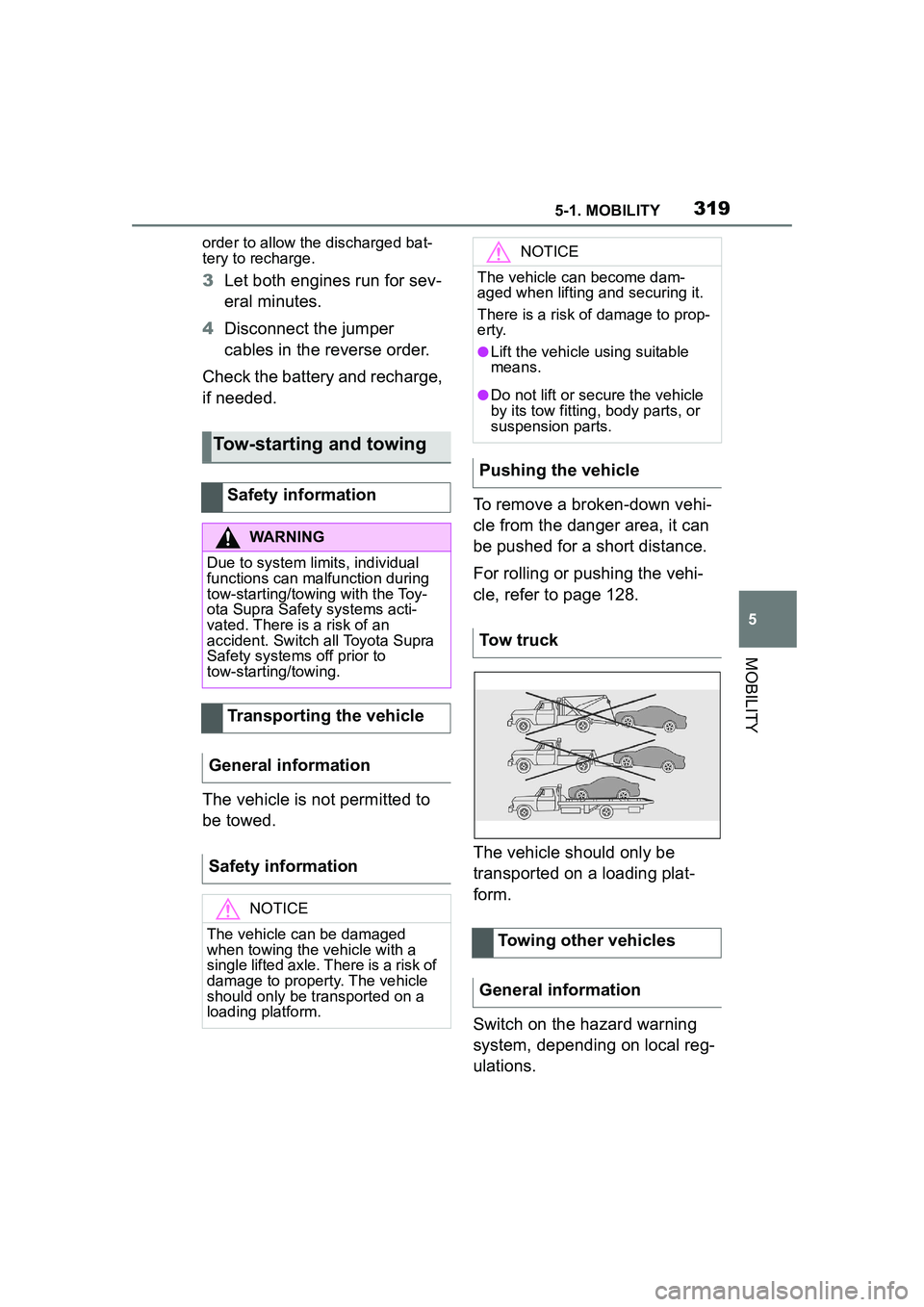2022 TOYOTA GR SUPRA suspension
[x] Cancel search: suspensionPage 9 of 356

91-1. NOTES
1
NOTES
turer to optimize vehicle func-
tions.
The majority of this data is vola-
tile and is only processed within
the vehicle itself. Only a small
share of data is stored in event
or fault memories based on an
event.
When servicing, for instance
during repairs, service pro-
cesses, warranty cases, and
quality assurance measures,
this technical information can be
read out from the vehicle
together with the vehicle identifi-
cation number.
Your Toyota dealer can read out
the information. The socket for
OBD Onboard Diagnosis
required by law in the vehicle is
used to read out the data.
The data is collected, pro-
cessed, and used by the rele-
vant organizations in the service
network. The data documents
technical conditions of the vehi-
cle, helps with the identification
of the fault, compliance with
warranty obligations and quality
improvement.
The data from the vehicle can
also be used to check customer
claims for warranty and guar-
anty.
Fault and event memories in the
vehicle can be reset when your
Toyota dealer performs repair or
servicing work.Depending on the vehicle equip-
ment, comfort and Customize
settings can be stored in the
vehicle and modified or reset at
any time.
For example, this includes:
• Setting for the seat position.
• Suspension and climate con-
trol settings.
If necessary, data can be trans-
ferred to the entertainment and
communication system of the
vehicle, e.g. via smartphone.
This includes the following
depending on the respective
equipment:
• Multimedia data such as music, films or photos for
playback in an integrated mul-
timedia system.
• Address book data for use in conjunction with an integrated
hands-free system or an inte-
grated navigation system.
• Entered navigation destina- tions.
• Data on the use of Internet services.
This data can be stored locally
in the vehicle or is found on a
device that has been connected
to the vehicle, e.g., a smart-
phone, USB stick or MP3 player.
If this data is stored in the vehi- Data entry and data trans-
fer into the vehicle
General information
Page 132 of 356

1323-1. CONTROLS
Adaptive variable suspension.
Steering.
Display in the instrument clus-
ter.
Cruise control.
When drive-ready state is
switched on, the NORMAL driv-
ing mode is selected automati- cally.
■Concept
Balanced tuning between
dynamic and efficient driving.
■Concept
Dynamic tuning for higher agility
with an optimized chassis and
suspension.
■Switching on
■Concept
Customize settings can be
adjusted in the customize driv-
ing mode.
■Configuration
Via Toyota Supra Command:
1 "My Vehicle"
2 "Vehicle settings"
3 "Configure SPORT INDIVID-
UAL"
4 Select the desired setting.
Reset Customize to the stan-
dard settings:
"Reset to SPORT STANDARD".
Overview
Displays in the instrument
cluster
The selected driving
mode is displayed in
the instrument cluster.
Driving modes
Button in the vehicle
ButtonDriving
modeConfigu- ration
SPORTSPORTCustom- ize
Driving modes in detail
NORMAL
SPORT
Press the button.
Customize
Page 224 of 356

2243-1. CONTROLS
Additional information:
• Radar sensors, refer to page 40.
The system may not be fully
functional in the following situa-
tions:
In tight curves.
When crossing objects move
at a very slow or a very fast
speed.
If other objects are in the cap-
ture range of the sensors, that
hide cross traffic. This chapter describes all stan-
dard, country-specific and
optional features offered with
the series. It also describes fea-
tures and functions that are not
necessarily available in your
vehicle, e.g., due to the selected
options or country versions. This
also applies to safety-related
functions and systems. When
using these functions and sys-
tems, the applicable laws and
regulations must be observed.
The chassis components are
optimized for the vehicle and its
scope of application and thereby
ensure the best possible Driving
Dynamics.
*: if equipped
The Adaptive variable suspen-
sion is an intelligent, controllable
sport chassis/suspension.
The suspension reduces body
movements with a sporty driving
style or on an uneven road.
System limits
System limits of the sensors
Functional limitations
Driving comfor t
Vehicle features and
options
Chassis components
Adaptive variable suspen-
sion*
Principle
Page 271 of 356

2715-1. MOBILITY
5
MOBILITY
Winter and all-season tires with
better cold weather performance
than summer tires.
Do not drive with a tire tread of
less than 0.12 in/3 mm, other-
wise there is an increased risk
of hydroplaning.
Do not drive with a tire tread of
less than 0.16 in/4 mm, as such
tires are less suitable for winter
operation.Wear indicators are distributed
around the tire's circumference
and have the legally required
minimum height of 0.063
inches/1.6 mm.
The positions of the wear indica-
tors are marked on the tire side-
wall with TWI, Tread Wear
Indicator.
Inspect your tires regularly for
damage, foreign objects lodged
in the tread, and tread wear.
Driving over rough or damaged
road surfaces, as well as debris,
curbs and other obstacles can
cause serious damage to
wheels, tires and suspension
parts. This is more likely to
occur with low-profile tires,
which provide less cushioning
between the wheel and the
road. Be careful to avoid road
hazards and reduce your speed,
especially if your vehicle is
WARNING
The temperature grade for this tire
is established for a tire that is
properly inflated and not over-
loaded. Excessive speed, under-
inflation, or excessive loading,
either separately or in combina-
tion, can cause heat buildup and
possible tire failure.
M+S
Tire tread
Summer tires
Winter tires
Minimum tread depth
Tire damage
General information
Page 280 of 356

2805-1. MOBILITY
3Insert the connector into the
power socket inside the vehi-
cle.
4 Correct the tire inflation pres-
sure to at least 2.0 bar.
• Increase tire inflation pres- sure: with standby state
switched on or the engine
running, switch on the com-
pressor.
• Reduce tire inflation pressure: press the button on the com-
pressor.
5 Unscrew the connection
hose of the compressor from
the tire valve.
6 Pull the connector out of the
power socket inside the vehi-
cle.
7 Stow the Mobility System in
the vehicle.
Do not exceed the maximum
permissible speed of 50 mph/80
km/h
Reset the Tire Pressure Monitor
TPM, refer to page 280.
Replace the nonworking tire and the sealant container of the
Mobility System promptly.
Tire chains cannot be mounted.
Snow tires should be used
instead.
The system monitors tire infla-
tion pressure in the four
mounted tires. The system
warns you if there is a loss of
pressure in one or more tires.
Sensors in the tire valves mea-
sure the tire inflation pressure
and tire temperature.
The system detects the
mounted tires automatically. The
system displays the specified
nominal pressure values on the
Control Display and compares
these values to the actual tire
Continuing the trip
Snow chains
NOTICE
■Driving with tire chains
Do not fit tire chains. Tire chains
may damage the vehicle body
and suspension, and adversely
affect driving performance.
Selecting tire chains
Tire Pressure Monitor
TPM
Concept
General information
Page 319 of 356

3195-1. MOBILITY
5
MOBILITY
order to allow the discharged bat-
tery to recharge.
3Let both engines run for sev-
eral minutes.
4 Disconnect the jumper
cables in the reverse order.
Check the battery and recharge,
if needed.
The vehicle is not permitted to
be towed. To remove a broken-down vehi-
cle from the danger area, it can
be pushed for a short distance.
For rolling or pushing the vehi-
cle, refer to page 128.
The vehicle should only be
transported on a loading plat-
form.
Switch on the hazard warning
system, depending on local reg-
ulations.
Tow-starting and towing
Safety information
WARNING
Due to system limits, individual
functions can malfunction during
tow-starting/towing with the Toy-
ota Supra Safety systems acti-
vated. There is a risk of an
accident. Switch all Toyota Supra
Safety systems off prior to
tow-starting/towing.
Transporting the vehicle
General information
Safety information
NOTICE
The vehicle can be damaged
when towing the vehicle with a
single lifted axle. There is a risk of
damage to property. The vehicle
should only be transported on a
loading platform.
NOTICE
The vehicle can become dam-
aged when lifting and securing it.
There is a risk of damage to prop-
erty.
●Lift the vehicle using suitable
means.
●Do not lift or secure the vehicle
by its tow fitting, body parts, or
suspension parts.
Pushing the vehicle
Tow truck
Towing other vehicles
General information
Page 344 of 356

344Alphabetical Index
Alphabetical Index
A
A/C button, see Air conditioning
............................................... 228
ABS, Antilock Brake System . 194
ACC, see Dynamic radar cruise control with full-speed range............................................... 203
Acceleration Assistant, see Launch Control..................... 130
Accessories and parts ............... 6
Activated charcoal filter ........ 231
Active Guard, see Toyota Supra Safety .................................... 172
Adaptive brake assist ............ 195
Adaptive variable suspension ............................................... 224
Additional coolant tank cooling, Capacity ................................ 332
Additives, engine oil types .... 297
Air circulation, see Recircu- lated-air mode....................... 229
Air conditioning ...................... 228
Air distribution, manual ......... 230
Air flow, automatic air condition- ing .......................................... 230
Air outlets, see Ventilation .... 231
Air pressure, tires .................. 264
Airbags .................................... 160
Airbags, indicator and warning light........................................ 162
Alarm system ............................ 92
Alarm, unintentional................. 93
All-season tires, see Winter tires ............................................... 274
Antilock Brake System, ABS . 194
Anti-slip control, see VSC ..... 195
Anti-theft protection, locking .. 79
Anti-theft protection, see Lug bolt lock ................................ 289
Apple CarPlay, connection to the vehicle ..................................... 73 Approved axle load ................331
Approved total weight ............331
Assistance when driving off, see
Hill-start assist control.........195
Assistance with breakdown ..315
AUTO program, automatic air
conditioning ........ ..................229
Auto Start/Stop function ........ 116
Automatic air conditioning ....226
Automatic cruise control with Stop & Go ..............................203
Automatic Curb Monitor, exte- rior mirror ..............................106
Automatic deactivation, front-seat passenger airbags...............................................170
Automatic headlight control ..153
Automatic high-beam .............156
Automatic locking ....................91
Automatic transmission.........126
Automatic transmission, Fluid ...............................................332
Automatic transmission, see Automatic transm ission.......126
Automatic unlocking ................91
Automatic vehicle wash .........322
Autonomous Emergency Brak- ing ..........................................192
Axle loads, weights ................331
B
Backrest curvature, see Lumbar support ................ ....................99
Backrest tilt ...............................99
Backrest, seats .........................96
Backrest, width .........................99
Bar for tow-starting/towing....320
Battery, changing, remote con- trol of the vehicle ....................81
Battery, disposing of ..............306
Battery, vehicle .......................305
Page 353 of 356

353Alphabetical Index
Reversing lights, bulb replace-ment, see Lights and bulbs . 304
Roadside Assistance, see Break- down assistance .................. 315
Roadside parking lights......... 154
Rolling code hand-held transmit- ter........................................... 236
RON recommended fuel grade ............................................... 294
Roof load capacity ................. 331
Roofliner ................................... 39
Rope for tow-starting/towing 320
Rubber components, care ..... 326
S
Safe braking ............................ 255
Safety belt reminder for driver's seat and front passenger seat............................................... 104
Safety belts ............................. 100
Safety belts, care .................... 327
Safety systems, see Airbags . 160
Safety systems, see Toyota Supra Safety ......................... 172
Saving fuel .............................. 257
Screen Mirroring, connection . 74
Screen, see Control Display .... 49
Screwdriver, see Onboard vehi- cle tool kit ............................. 303
Sealant, see Mobility System 275
Seat heating ............................ 108
Seat, see Memory function .... 107
Seating position for children. 111
Seats, front ............................... 96
Securing cargo ....................... 247
Selection list in instrument clus- ter........................................... 145
Selector lever, Automatic trans- mission.................................. 126
Sensors of the vehicle ............. 40
Sensors, care .......................... 327
Service and warranty ................. 7 Service requirements .............141
Service requirements, see Condi-
tion Based Service CBS .......301
SET button, see Cruise control ...............................................199
SET button, see Dynamic radar cruise control with full-speed
range ......................................203
Set speed, see Dynamic radar cruise control with full-speed
range ......................................203
Settings on Control Display ....60
Settings, locking/unlocking .....90
Shift paddles on the steering wheel .....................................126
Side airbag ..............................160
Side protection .......................217
Signaling, horn .........................36
Signals when unlocking, see Confirmation signals from the
vehicle .....................................91
Sitting safely .............................96
Sizes, see Dimensions ...........330
Smallest turning radius..........330
SMS text message, supplemen- tary .........................................135
Snow chains............................280
Socket for OBD Onboard Diagno- sis ..........................................302
Sockets ....................................238
SOS button, see Intelligent emer- gency call ..............................316
Special equipment, see Vehicle features and options ................4
Speed Limit Assist ................. 211
Speed limit display, see Speed Limit Info ...............................143
Speed Limit Info......................143
Sport chassis/suspension, see Adaptive variable suspension...............................................224
Sport displays .........................149